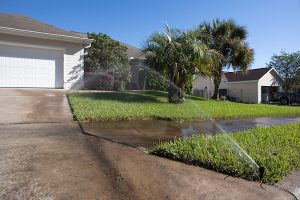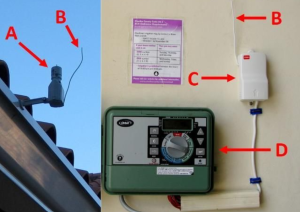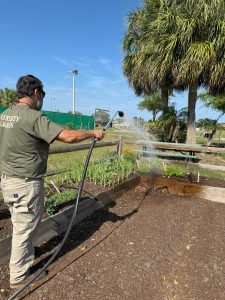What is Overhead Irrigation?
When we say ‘overhead’ irrigation, it refers to any system or cultural practice that describes irrigating from above. Most commonly, this term refers to sprinklers. Sprinklers spray water over a broad area for uniform coverage. There’s a large variety of sprinklers that are relatively inexpensive and easy to install.
The most common sprinklers are spray head, rotary head, and impact sprinklers. All of these heads are ideal for different scenarios; spray heads are great for smaller areas while rotary heads are better for larger areas. Irrigation systems can be customizable and programmed on timers to water your garden. When designing your system, ensure you have head-to-head coverage – meaning the water from one sprinkler should reach the head of the next sprinkler, so there is an overlap between the sprays.
Additionally, you absolutely must match the sprinkler precipitation rates – so always confirm the number of gallons per minute or hour of your selected system, and never mix rotor heads with spray heads, since they never will have matching precipitation rates. Irrigation systems will also need regular maintenance. It is convenient to ‘set and forget’ your irrigation system but it will cause problems in your landscape in the long run. Ideally once a month do a “wet check”, turn on the system and look for the sprinkler’s spray is directed toward the lawn, landscape, or garden. Look for leaks, clogged nozzles and filters, broken or worn heads, and grass growing over the sprinkler preventing it from popping up. If you have not calibrated your system this year, make sure you set the system to run each zone once. Read this publication to find out how you can calibrate your system, it’s simple, but extremely important step for efficient irrigation. These systems require proper installation and maintenance to remain functional and efficient.

Efficient Watering
Efficient watering wets only the root zone and does not allow water to run off. If you are seeing water running off from your landscape and into the gutter, you are watering too much. The amount of water should never change, but the frequency should change as the season change. Turf needs more water during its growing season, typically mid-March to mid- October so aim to water 3/4 of an inch per watering. Meaning, set your system to deliver that amount of water each time! If your turf needs more water than that, up the frequency of waterings, not the amount of water per application, as the watering restrictions will allow. The best time to water is in the early morning, and following that, the evening is the second-best time. During these times of day, the temperature is cooler and there is less wind. If you water during the day you’re likely to lose 40%-60% of water (and money) due to evaporation. Always keep an eye out for watering restriction from the Water Management District, click here for more information or your local city or County ordinances, which might be more restrictive than what the Water Management District dictates.
So, when do you water? Check the soil, is it dry? If so, it is recommended to water 3/4 of an inch per event. Remember, the amount of water per event should remain the same, only the frequency of waterings should change. For more information, read this publication. Always water on an “as needed” basis, too much water can cause root rot, weed growth, pests, and diseases, and many other problems in your lawn or garden. Too frequent waterings can promote shallow root systems, which lead to vulnerable turf and garden plants.
Seasonality is important, if your plant is in season, it means it is actively growing. Dormant plants need less water, and fertilizing and watering dormant plants causes them to grow unnaturally. This can create stressed plants, and these plants may change color and should not be encouraged to grow. For example, St. Augustine grass is a warm-season grass and goes dormant in the cooler months. You may notice your grass fade in color and slow in overall growth, which helps to protect against the cooler temperatures (frost and freeze). Hold your hoses, it is common for the grass to fade from a lush green to yellow-green or brown, especially after frost and freezes (this normal and will remain off color until late spring). Refrain from the urge to fertilize, which will NOT turn the grass green and adding these nutrients can encourage pests, diseases, and other problems during the growing season.
It is the Law
In all of Florida, irrigation frequency (e.g., time of day, day of week, etc.) is regulated by water management districts, and sometimes city and County ordinances. Know the regulations in your area and comply with the law. Here is Pasco County watering schedule.
A lesser known fact is that automatic irrigation systems must have a functioning rain sensor or other device to bypass irrigation if sufficient water has been supplied by rainfall. You likely have one of these on the roof of your home. Licensed contractors are required by law to install, repair, or replace these control devices if they are not installed and working properly before doing any other work on an irrigation system (Section 373.62, Florida Statutes). Read more here.

Credit: Bernard Cardenas, UF/IFAS
Explore Your Options
While you could say this method of irrigation mimics natural rainfall, there are many drawbacks to overhead irrigation. Watering overhead wets the foliage of the plants, which invites pests and diseases. Compared to conservative watering practices, this method can encourage weed growth. On hot, windy days more water evaporates and there’s a higher chance of run-off. This makes it hard to track how much water the plants are getting, versus how much water is being wasted. This method is not necessarily bad for plants, but there are alternative practices that are much more efficient for your plants and wallet.

Tips for the Floridian Gardner
- Water plants when they are wilted in the early morning (many plants wilt in the heat of the afternoon this is “heat-wilt”, and the plant recovers in the evening) and wait to water until the plant starts to wilt again. This practice builds strong root systems and conditions plants to survive with less water.
- Set your system to deliver 3/4 of an inch of water per application. If the area needs more water, up the frequency of the waterings, not the run time.
- Stay informed on the forecast, and work that into your watering schedule. If you have a sprinkler system set on a timer, it could be detrimental for your plants if they get watered, and then it rains.
- Established trees and shrubs (plants 3+ years old) should not receive supplemental watering.
- Calibrate and maintain your system frequently ( check to see if the rain sensor is still functioning they have a short lifespan of typically one to two years before they need to be replaced!).
How Efficient are Your Irrigation Practices?
A human would need 16,000 gallons of water for a lifetime. But your landscape needs 625 gallons of water for every 1000 square feet. How are you doing on your irrigation efficiency?
Calculate how many square feet of landscape you need to irrigate, the property appraiser website is a handy way to know the size of your lot and the size of the non-irrigated areas (house, driveway, pool etc.) You might have a 5000 square feet lot but only 2500 square feet are irrigated. It takes about 625 gallons per irrigation cycle to water 1000 sq. ft. So, if you have 2500sq. feet. of irrigated landscape, it will require about 1,600 gallons per irrigation cycle or if watering once a week about 6,300 gallons. Read more about efficient watering practices here.
So how efficiently are you irrigating? Check you water bill, calculate your irrigatable area to get a baseline, but also remember there is other water use indoors, typically you can assume about 2,000gallons of indoor water use per person each month. You might have other water needs such as filling a pool, which if done by a hose is about 400 gallons for every hour the hose is running. If you discover your water use is well above the predicted need, do a wet check of your system and check for issues, also check your timeclock for multiple start times, and multiple programs on “B, C or D”. Most of use only need one program in A and no programming in B, C or D and only one start time. Learn more about setting your irrigation controller here.
Conclusion
By being mindful of how we use water in our gardens and on our lawns, we can help conserve this precious resource while keeping our plants happy and healthy. Overall, promoting conservation, efficiency, and responsible irrigation practices ensures the availability of clean water and protects Florida’s environment to supporting future generations.
For more information about water use and conservation in Florida, see Water Resources.
Have a question?
If you have any questions about gardening in Central Florida, please contact UF/IFAS Extension Pasco County at 352-518-0156. For more information on UF/IFAS Extension Pasco County Community Gardens, and how you can join one, visit http://sfyl.ifas.ufl.edu/pasco/. Supervising agent: Dr. Whitney Elmore.
Follow us!
We have several ways to connect. Visit our Facebook, Instagram, Eventbrite, Blogs, Florida-Friendly Facebook, & Website.
Visit our page for more tips and tricks on maintaining a home garden!
 5
5
